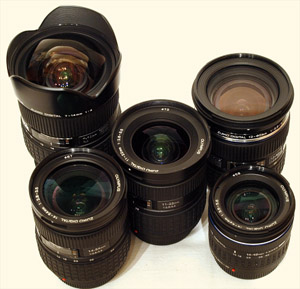

E-SYSTEM
comparing the e-system zooms at 14mm
7-14; 11-22, 12-60, 14-54, 14-42


E-SYSTEM comparing the e-system zooms at 14mm 7-14; 11-22, 12-60, 14-54, 14-42 |
|
|
INTRODUCTION: The favourite focal length of many 35mm photographers was 28mm. This is reflected in many of today's popular Olympus Zuiko Digital standard zooms that start at 14mm and others covering 14mm. Getting wider than 14mm is an expensive fact of life. The older ZD11-22mm has a ticket of some £450 and the brand new SWD 12-60mm lens from Olympus comes at a cost of £700! The fabulous ZD7-14mm is a staggering £1200. If you read my examination of the overlapping focal lengths of the ZD14-54mm and ZD11-22mm which is here, I concluded that 'in comparison' to the ZD14-54mm at 14mm the ZD11-22 offers a better (wider) angle of view at the same 14mm setting. If that was the case between those two lenses I wondered if there was any other significant differences at 14mm focal length between any of the current ZD's that cover that particular length. Well, as Harry Hill says 'there's only one way to find out' so I organised a simple shoot-out between the five lenses that currently cover 14mm. These are ZD14-54mm; ZD11-22mm; ZD7-14mm; ZD 12-60mm SWD and the budget ZD14-42mm.
I set my tripod up with the ZD14-54mm on board and carefully aligned the NW edge of my lounge wall as perpendicular as I could to a line 5mm from the left hand side of the viewfinder. I set the E-3 to my usual settings of A priority (f=6.3) S-AF, ISO 100, Picture Mode Natural, Gradation Normal, and applied -0.3 compensation and let the meter determine the shutter speed. No filter or hood was used on any lens except the ZD7-14 which has an integral petal hood.
I examined the above results carefully in PS noting the differences between left and right hand edges of the recorded images with each lens in turn. I conclude the lens giving the widest angle of view when set to 14mm is the humble ZD14-42mm. This came as a shock to me too! The ZD7-14 gives a slightly better result on the left hand edge but loses out to the wider ZD14-42mm on the right hand edge. So, overall I give the result to the budget ZD14-42mm. Next I look carefully at each end of the images (I'm only interested in the horizontal not vertical coverage) and mark each edge with the results from lenses that were significantly less wide at 14mm than the winning lens.
COMPARISON 1: The above image is carefully marked so you can see:
Please note the coverage from the ZD11-22mm is almost identical to the ZD14-42mm at both edges. From these results and IF you take the ZD14-42mm as giving an accurate measurement of its focal length coverage, both the ZD14-54mm and the new ZD12-60mm SWD offer slightly less than their declared focal length (zoom) spreads.
WHAT ABOUT SHARPNESS? I've selected an area from the mid right-hand side of the image for crop and comparison.
COMPARISON 2: These crops reveal more or less what I expected though I thought the ZD11-22mm would do better.
The crops are shown at pixel level and I'm not surprised by the results. To be honest there's not a huge difference between any of them. If you could not compare them directly I feel sure most folks would be delighted with any one of them, including the winner in the 'widest' stakes which is also the loser in the 'sharpness' stakes.
CHROMATIC ABERRATION: I also cropped out the top left-hand corner of each image to compare CA around branch edges against a lighter sky. Because the sky was not typical 'milky white' but rather sky blue the amounts of CA were negligible. The worst performer was the ZD11-22mm that showed only small fringes of purple; next was the ZD14-54mm with even less; next was the ZD14-42mm with about the same as the ZD14-54; next was the ZD7-14 with tiny areas of fringing in just the odd place; best was the new ZD12-60mm SWD with no fringing whatsoever on this test image. So small was the problem it was not worth while showing the crops. However my past experience tells me that with a whiter sky the results shown above will be significantly amplified pro-rata. For instance, I've always been a little disappointed with the amount of CA shown by the ZD11-22mm. The ZD12-60mm SWD on the other hand shows the best control over CA in any of the standard zooms I've used with little to no fringing aberrations even against white skies; another good reason to put it on your shopping list.
CONCLUSION: I've always been a great believer in the old addage 'you get what you pay for', but on this occasion I'm not totally convinced. Certainly the more expensive and faster lenses give you an advantage in gloomy conditions and of course they are weather sealed too. But the little budget lens can be had for £60! It may be marginally the softest of the bunch, but it delivers the greatest value for money. This article seeks nothing other than to inform. Only you can decide what equipment you want/need for your use. Bear in mind I own these lenses, out of my own pocket; I have nothing to gain or lose by publishing this article, photographs, examples or opinion. |
|
HOME |
INTRO |
BOOKS |
OLYMPUS CIRCLE |
QUEST |
TOC MEMBERS |
GALLERIES
|
| Posted October 23rd 2006 14:30 | Copyright © 2006 John Foster |